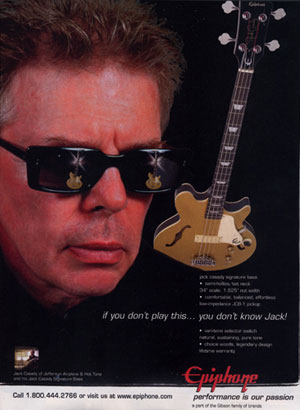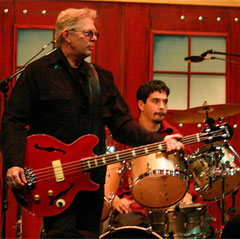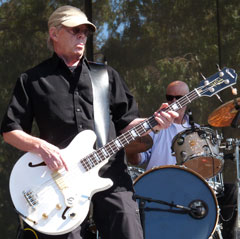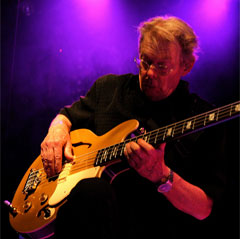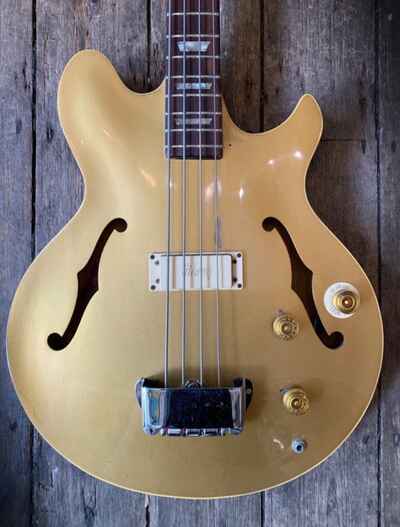Gibson Les Paul Signature Bass
FlyGuitars From using solid body basses again, you then went to the Gibson Les Paul Signature bass that you found in the mid 80's?
Jack Casady Yeah, pretty much. I did a project with Marti Balin and Paul Kantner and we called it the KBC band in 1985. I think in '83 Jorma and I got back together to do a large tour and during a hiatus again in '84 I did one record with Paul and Marti under that name and with that band I used solid body basses. In '85 about the time that I was to move to New York for a while I was visiting this little Music store called The Chelsea Music Room right next to the famous Chelsea Hotel that I stayed in many a year during the early 70's. I saw the Gibson in the window there with the double cutaway and I thought boy this is new out cause I didn't even know it was made but it was a full scale neck and I got the instrument and just fell in love with it right away. It was everything I wanted; it had the hollow body but it was a little different than the Guild because it didn't have a solid block of wood down the back. It went up to the guitar top and along the back, and it only came up about 5 8ths of an inch; and it left an actual space between that block and the pressed top of the instrument. So you could actually thump on it and get a hollow sound out of it; but the block of wood that was fluted at the back that went along the back of the guitar kept any unpleasant feedback down. You got a nice mixture of f hole hollow body with the Guild itself with a solid block of wood that went all the way up to the top. So I liked this, but I also liked because it had a transformer with a low impedance set up for the pickup. It was a very warm full dynamic sound so I got that instrument and played that for a number of years.
FlyGuitars So did you use that as your main instrument up until the point you spoke to Epiphone and had the signature bass made?
Jack Casady I did, that was my primary instrument. What I found though was it was a bit muddy, basically when you play with many other instruments or a modern keyboard instrument you start to loose some of the distinction. So at that time I could utilise a good full length sound but I really enjoyed the tonal qualities of the hollow instrument. I was able to get both a good rock sound but something more melodic and a little more jazzy when I wanted. I went back to playing the hollow body around '85 and I pretty much stayed although when you do a session or something you're likely to use a lot of different instruments.
Epiphone Jack Casady Signature Bass
FlyGuitars So how did the Epiphone bass come about?
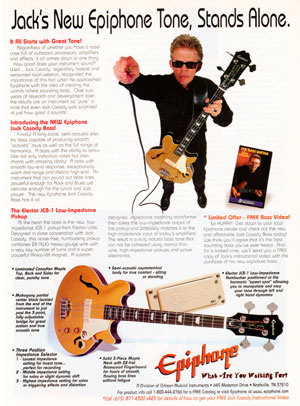
Jack Casady When in 1998 I approached Gibson about reissuing that bass they turned me over to Jim Rosenberg, President of Epiphone. They owned Epiphone and they thought that the bass was too much of an odd duck for Gibson to put back out again. I was fortunate enough to have interest from Jim and he said we can make this bass affordable by making it in Korea and I've got some great technicians and guitar builders in Korea. I took the bass and said I love the bass the way it is but there was a certain little change I wanted to make on the neck and I said the pickup by today's standards is a little translucent and it sounds ok if you're playing in a very small combo but if you have to compete with any kind of keyboards or anything with a lot more dynamic range it gets lost in the track. I said I wanted to build my own pickup and get more body out of the sound and to have more presence so I went down to Nashville to Gibson and worked with JT Riboloff.
FlyGuitars Right
Jack Casady We duplicated the pickups as they were on the old '72 model but then I took the pickup and added more Alnico power to it, another three quarters of an Alnico magnet on the other side. Also I took a page out of a lot of lap steels, I took the windings that were used for those pickups and used a higher gauge wire. I used a 28 gauge wire, very thick. I wanted to thicken the sound up, and they said that I could do anything I want. I could add one pickup, two pickups, three pickups. I said what I want is one great pickup that I can have at any expense.
FlyGuitars That makes sense rather than having multiple pickups.
Jack Casady That took quite a while to get right but once it was finally right about a year later we put it in production. Now the instrument itself I must say, the Korean craftsmanship was far superior to the original Gibsons, of which I have three. Anything in the early 70's, cars or guitars, the workmanship was really quite shoddy. The Gibson company had been sold, Fender had been sold, there was a lot of problems both with Fender and Gibson.
Jack with three different Epiphone signature basses.
Photos courtesy John P. Rossignol, David Sidle and Sam Holloway
FlyGuitars Yes, they're generally regarded as the less desirable.
Jack Casady The bass became available in 1998 and I'm proud to say it's still being sold today.
FlyGuitars It seems very popular, a lot of people buy them.
Jack Casady It's doing better than they thought. You know it's somewhat of an odd duck but I wanted a long scale f hole bass out there. The Guild f hole guitar wasn't a true hollow body, it had a block down the centre. This Gibson bass is a true hollow body. It has a light pine fluted block that's about a five eighths of an inch in depth attached to the back of the body but there's an actual space between that and the top of about three quarters of an inch so that the fluted block there dampens it enough to keep it from feeding back but it still has an acoustic quality and that's why I think that bass sounds so good along with the pickup.
FlyGuitars Yes, it's a good sounding bass. So do you not use the Gibson ones at all now live or for recording?
Jack Casady No. See the problem is it was an ok bass and it sounded good by itself. A lot of vintage instruments, the pickups get tired and they get less distinct. Just because an instrument is old doesn't make it sound good. When I did my research for this and I was choosing the pickup combinations we did many different windings and configurations and when I was testing all these out I'd record them side by side the original Gibsons.
I didn't want it to sound just as good as the original Gibson I wanted it to sound better and also wanted it to sound better in context to the music. There are certain instruments out there like a P bass or Jazz bass that you can set in the track and you can have the volume of the instrument high or in the track or even both but low and you can still get the distinction of the instrument.
FlyGuitars Yes
Jack Casady Now the old Gibsons, what would happen is you get inside that track with the other instruments going on and you start to lose certain notes. It doesn't mean it sounds bad, and I used one for almost five years but that was part of the problem that I would have both in person and in recordings. It felt like they had to eq the bass track. Once you start doing that you start loosing the original quality of the sound.
So I wanted a sound that would come out of the instrument that would hold up on it's own no matter what. That's what I worked for, and that's what I think I got. In answer to your question I don't use the vintage ones any more.
FlyGuitars So you pretty much just use the Epiphone now?
Jack Casady My primary instrument is the one that I get the most variety of tone out of, The Epiphone JC bass. That's the one that I strive to use the most. There are a lot of people like session players in general that will use a number of different instruments but I'm not a session player and I don't get a call to do a lot of different kinds of styles of music. So my needs are a little bit different. I think of it more as find a great/good sounding acoustic instrument and work within that instrument and you really pull everything you can out. And it's an instrument that I want to play, I pick it up and I'm always happy with the way it sounds. It's a great bass!
Thanks to Graham Fieldhouse and Jack Casady
Further reading: JackCasady.com | HotTuna.com
Epiphone Jack Casady for sale
1974 GIBSON LES PAUL SIGNATURE BASS - GOLD & FLIGHT CASE
London, SW6***, UNITED KINGDOM
£5250
1974 GIBSON LES PAUL SIGNATURE BASS - GOLD
Here is rare Gibson Les Paul Signature Bass in good original condition. Arched Maple top, Walnut back and sides. Single ?Super Humbucking?? pick up, semi hollow with a 34 inch scale length, 20 fret, maple centre block, a master volume and tone and a rotating three setting level switch. Laminated Mah gany neck and a Three point Tunomatic bridge. Two outputs, one high and one... more

